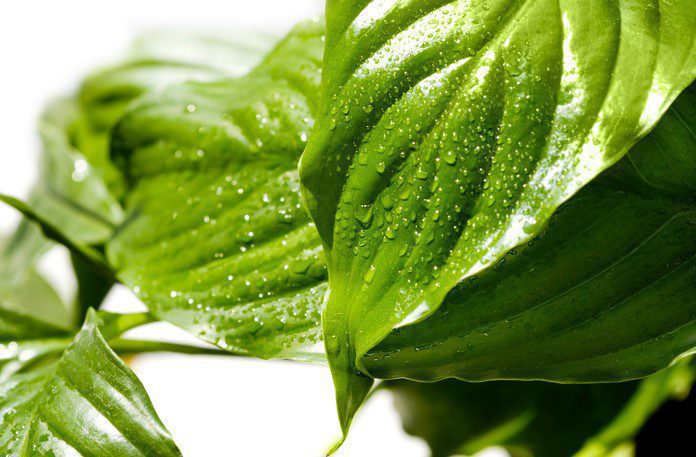Spathiphyllum Wallisii (peace lily) Spathiphyllum is a native of South America, and the name is derived from the Greek ‘spathe’ (bract) and ‘phyllum’ (leaf), the spathe being leaf-like in shape. Sometimes you can encounter the wrong name, “spathophyllum”.
The actual flower is yellow, relatively small, and contained within a white, leaf-like bract. This is a valuable and long-lasting plant displaying tufts of elegant, arching, deep-green leaves.
Although this plant can tolerate relatively low light conditions, it will only produce flowers if located in moderate light.
Normal room temperatures are ideal, with a minimum low of 13C. Avoid dry air from heating systems and encourage humidity by grouping plants.
How to care for spathiphyllums
During the summer months, keep them away from the full glare of the sun. They need a bright position with plenty of light, but not too much. Over the winter, they can be exposed to more sun and light.
They will get by in a shady position but may not produce so many flowers. Do not stand them near drafts.
Spathiphyllums can be grown in shady areas that receive plenty of light and humidity in warmer parts of the country.
Spathiphyllum Wallisii is unique in that the leaves can look okay for one minute and then suddenly collapse over the edge of the pot.
This usually happens when the soil has dried out, especially during a heatwave.
Depending on the temperature, watering twice a week should be sufficient in summer, with maybe an extra watering if the temperature goes over 34.
During winter, the soil should be kept just moist—water once every eight days or when the soil feels dry.
Spathiphyllum Wallisii loves humidity. If you live in a dry region, stand the pot on a saucer of water filled with pebbles. Spray the leaves regularly with rainwater, distilled water, or boiled (and then cooled) water (tap watermarks the leaves).
Any dead flowers or dying leaves should be trimmed away with a clean knife or scissors.
Feed the plant with a liquid fertilizer every two or three weeks.
The optimum temperature for spathiphyllums is between 16 and 20 in winter. They may get by at a lower temperature but will produce fewer flowers.
Why Do Peace Lily Leaves Turn Black
Black leaf tips are extremely prone to be induced by underwatering than overwatering. (Yellowing of petals is further expected with overwatering.)
However, the black tips are more likely a manifestation of poor moisture than underwatering. If achievable, try arranging the peace lily with alternative houseplants to enhance the humidity in the range around the plants.
The blackened leaf tips could likewise be owing to excess salts in the soil, either from too extreme fertilizer or fluoride/chlorine in the water.
Propagating Spathiphyllum wallisii
Spathiphyllum Wallisii is very easy to propagate and should be divided every two or three years. They enjoy good soil, so make sure you have a clean houseplant potting mix.
Remove the whole plant from its pot and divide the root stock, ensuring each piece has a root and a shoot.
Two or three roots should be potted in each container. The pots should not be oversized. As a rule, they produce more flowers if they are slightly root-bound.
Success in producing new plants depends on high humidity being maintained.
The leaves should be cleaned periodically with a solution of milk and water. Avoid leaf shine as it can clog the pores of the delicate leaves.
Check the leaves occasionally for bugs. If they are affected, spray them with an insecticide or a mixture of soap and water (2 teaspoons to 1 liter of water) and follow up after a week to 10 days.
Spathiphyllum Watering And Problems
Even though you may not get a spectacular shower of blooms, the Peace Lily is part of a group of plants used in the NASA Clean Air Study. It effectively removes airborne pollutants such as benzene, carbon monoxide, and formaldehyde, the latter being present in a high percentage of new homes.
Spathiphyllum Wallisii is a broadleaf plant and, as such, tends to collect dust. Clean the leaves with a warm water spray or wipe the leaves with a soft cloth, once a month or oftener as the need arises.
Water Spathiphyllum thoroughly and let dry to the damp-dry stage. Few are the problems of the Spathiphyllum, but water tends to be the number one killer of the Peace Lily.
To be precise, either the lack of it or the overabundance of it causes problems. Peace Lilies will collapse in a heap, sulking and pouting if not given enough water.
This terrifying situation is often overcompensated by pouring on the water until the roots of the poor plant drown. Now you have double jeopardy.
Watching and checking each day carefully till a routine is established will help prevent both situations from happening.
Place Spathiphyllum Wallisii in a location away from direct sunny exposure; the sun will cause the plant to burn. Filtered south light or a north window will be fine, and these plants appreciate a bit of fertilizer now and then.
Spring, summer, and fall, I usually give a 10-15-10 fertilizer half strength for houseplants. In winter, I let them rest and withdraw any fertilizer.
Winter can be a challenge; peace lilies will stay wet longer than average on long, overcast days without much daylight. Watch the watering at this time and adjust accordingly.
A well-draining pot will help with the health of this plant. Don’t over the pot; keep the roots healthy by potting up to 2 inches larger than the present size.
Soil is generally an all-purpose houseplant mix with a touch of sand added for good drainage.




























Comments are closed.